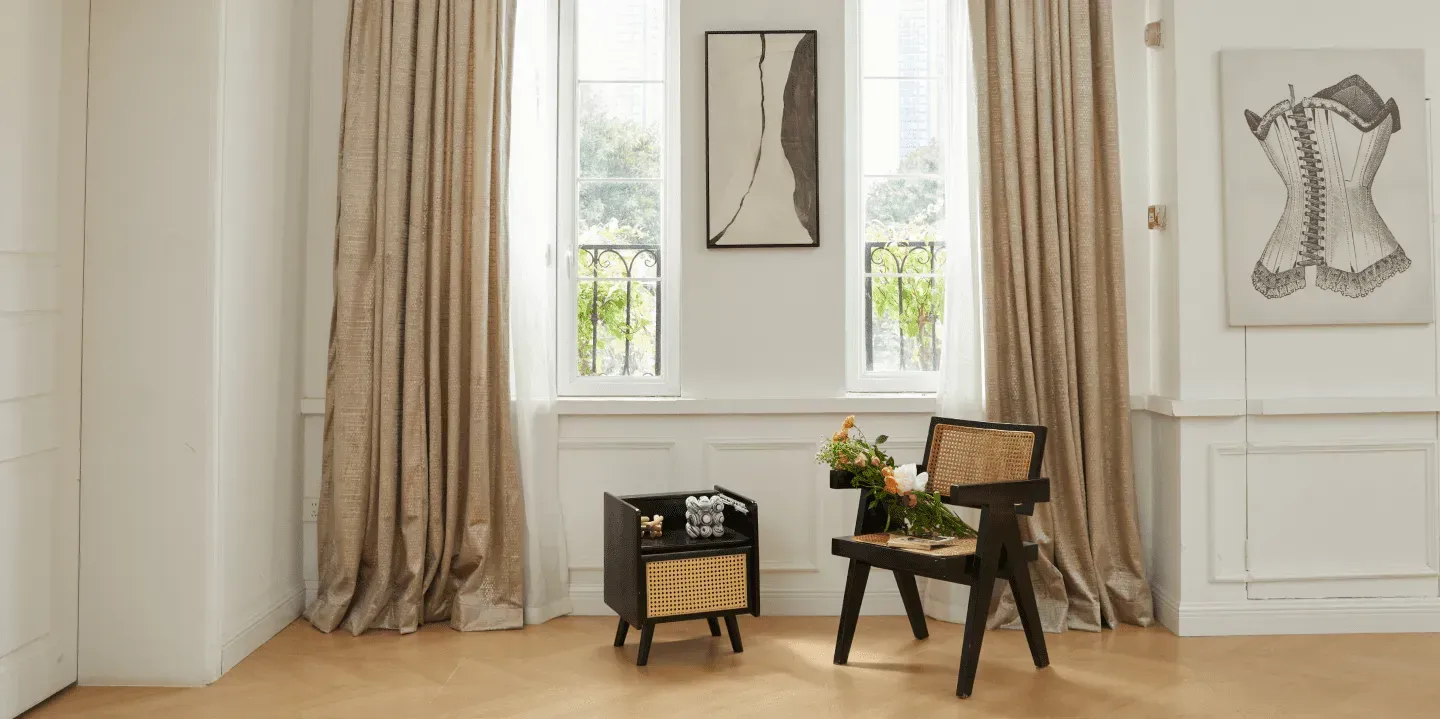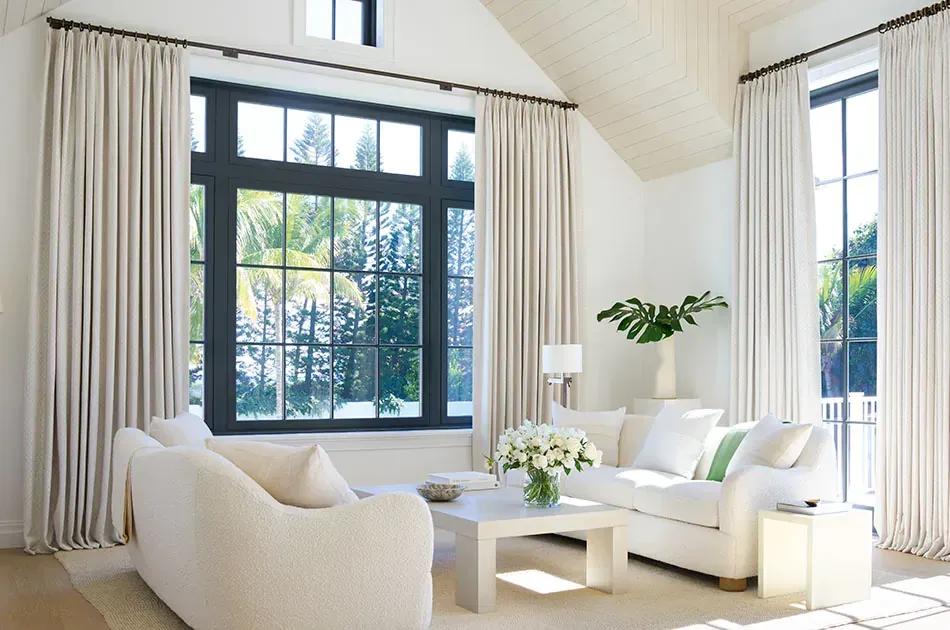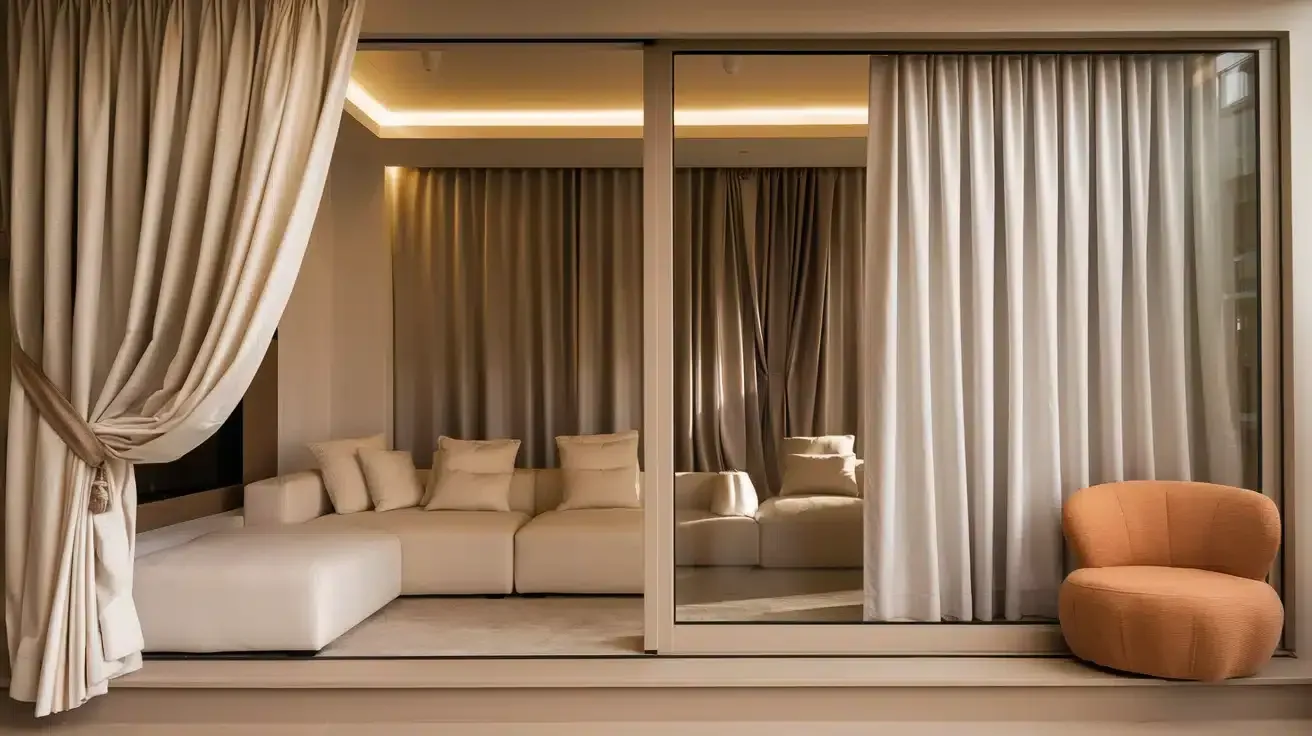What Is the Difference Between a Panel and a Drape?
TLDR;
A panel is a single piece of fabric used to cover windows, typically lightweight and available in sheer, blackout, or decorative forms. A drape is a heavier, often pleated and lined
window treatment that adds formality, insulation, and enhanced light control to a space.
What Is a Window Panel? (With Examples)

A window panel is a single curtain unit designed to hang from a curtain rod and cover part or all of a window.
It’s a staple in both casual and formal settings due to its versatility. Window panels come in a variety of lengths, widths, fabrics, and styles to suit different functional and decorative needs.
Types of Window Panels
- Sheer Panels
- Made from lightweight, semi-transparent fabrics like voile or chiffon
- Allow natural light while offering limited privacy
- Common in living rooms or layered under heavier treatments
- Blackout Panels
- Constructed with thick or special blackout materials
- Designed to block out light and provide privacy
- Ideal for bedrooms or media rooms
- Decorative Panels
- Often used for aesthetic purposes rather than functionality
- Made from a range of fabrics including cotton, silk, or polyester
- May feature patterns, textures, or embellishments
Key Features of Curtain Panels
- Available as single or double panels
- Typically sold individually
- Can be rod-pocket, grommet-top, tab-top, or pinch pleat
- Vary in width, with standard widths ranging from 40 to 54 inches
- Lengths can range from café style (24-36 inches) to floor-length (84+ inches)
What Are Drapes? (And How They Differ from Curtains)

Drapes are traditionally heavy, pleated, and lined curtains made for insulation, light control, and formality. —one of the key points when comparing Curtain vs. Drapery for your home.
Unlike basic panels or lightweight curtains, drapes offer both decorative impact and functional benefits, particularly in more formal or traditional interior designs.
Common Drapery Materials
- Velvet: Adds luxury and weight, suitable for dramatic formal spaces
- Brocade: Decorative woven fabric, often patterned and rich in texture
- Silk: Elegant and glossy, used in high-end settings
- Thermal-lined Cotton or Polyester: Practical for insulation and room darkening
Typical Use Cases for Drapes
- Bedrooms: Blackout-lined drapes offer privacy and better sleep
- Living Rooms: Frame windows with elegance, especially in formal spaces
- Dining Rooms & Studies: Elevate traditional decor styles
Core Features of Drapes
- Often floor-length or longer, sometimes "puddling" on the floor
- Include linings for light blocking, sound dampening, or thermal insulation
- Use pleated designs (pinch pleat, goblet pleat, or box pleat)
- May require traverse rods for opening and closing with a cord
Panel vs. Drape: Side-by-Side Comparison
Comparison Table
| Feature | Window Panel | Drape |
|---|---|---|
| Fabric Weight | Light to medium | Heavy |
| Lining | Optional (often unlined) | Usually lined |
| Formality | Casual to semi-formal | Formal |
| Light Control | Varies – Sheer to Blackout | Strong – Typically excellent |
| Length | Short to floor-length | Typically floor-length or puddled |
| Use Case | Everyday use, layering, light filtering | Privacy, insulation, formal decor |
| Maintenance | Often machine washable | Often dry-clean only |
Pros and Cons
Window Panels
Pros:
- Budget-friendly
- Easy to hang and maintain
- Available in wide styles and materials
Cons:
- Less effective at blocking light or cold
- May look too casual in formal spaces
Drapes
Pros:
- Superior insulation and privacy
- Elevates the elegance of a room
- Durable and long-lasting
Cons:
- Typically more expensive
- May require dry cleaning
- Heavier and harder to install
Which One Should You Choose – Panel or Drape?

Your choice between a panel and a drape depends on your room’s function, style, and your personal needs.
Use-Case Scenarios
- Casual Decor (Boho, Minimalist): Choose a lightweight panel
- Formal Dining or Sitting Room: Opt for drapes with pleats and lining
Budget-Friendly Spaces (apartments, rentals): Go for unlined panels - Light Blocking Needs (nurseries, bedrooms): Use lined drapes or blackout panels
- Layering Look: Combine sheer panels with decorative drapes
Quick Decision Guide
- Do you want something easy and affordable? →
Panel
- Do you want something elegant and insulating? →
Drape
Care, Cost & Lifespan: Drapes vs. Panels

Cleaning & Maintenance
- Window Panels
- Most are machine washable
- Easier to maintain in busy households
- Drapes
- Often labeled dry-clean only
- Heavier fabrics and linings make home washing difficult
Durability & Lifespan
- Panels: May fade or wear more quickly, especially sheer options
- Drapes: Tend to last longer due to thicker, more resilient materials
Budget Considerations
- Panels
- Pre-made options start at low prices
- Easy to find at retailers like Target or IKEA
- Drapes
- Often custom-sized or sold in pairs
- High-end fabrics increase the cost
- Longer installation process (e.g., pleats require hooks or rings)
Styling Panels & Drapes for a Designer Look

How to Style Curtain Panels
- Use tiebacks for an open, airy look
- Combine with valances to soften the top frame
- Choose bold colors or prints to add visual interest
Layering Panels and Drapes
- Combine sheer panels under blackout drapes
- Use multiple panels to create fullness
- Mix textures (linen panels + velvet drapes) for depth
Hardware Matters
- Rods, rings, and finials can complement your style
- For drapes, consider decorative rods that can handle more weight
- Add brackets and center supports for extra-long spans
Drapes vs Panels in Real Homes

A picture is worth a thousand words—here’s how these treatments look in real spaces.
Drapes in Formal Settings
- Floor-to-ceiling velvet drapes in a classic living room
- Brocade drapes with pleats framing French doors in a dining room
Panels in Casual Spaces
- Sheer white panels in a coastal-themed bedroom
- Linen-look panels on black rods for a modern farmhouse kitchen
- Use this contrast to help visualize what fits your space best.
FAQ: Panels, Drapes, and Other Window Treatment Terms
What’s the main difference between a curtain panel and a drape?
What’s the main difference between a curtain panel and a drape?
Are drapes always floor-length?
Typically, yes. Drapes are designed to add elegance and coverage, often touching or puddling on the floor.
Can you use panels and drapes together?
Absolutely. Many designers layer a sheer panel underneath and a decorative drape overtop for style and light control.
What is a grommet panel?
A grommet panel features large metal rings at the top, allowing it to slide smoothly across the curtain rod without additional hardware.
What’s the difference between a panel, curtain, and drape?
- Panel: A single curtain piece
- Curtain: Generic term that includes panels and other styles
- Drape: A formal, lined, often pleated curtain
Which Window Treatment Is Right for You?
Choosing between a panel and a drape comes down to your needs for style, function, and budget.
- Go with panels for light control, flexibility, and ease of installation
- Choose drapes for elegance, privacy, and insulation
At
Simply Windows, we help clients find the perfect balance of form and function. Whether you're designing a cozy family room or a formal sitting area, we offer tailored window treatment solutions to suit your taste and needs.

